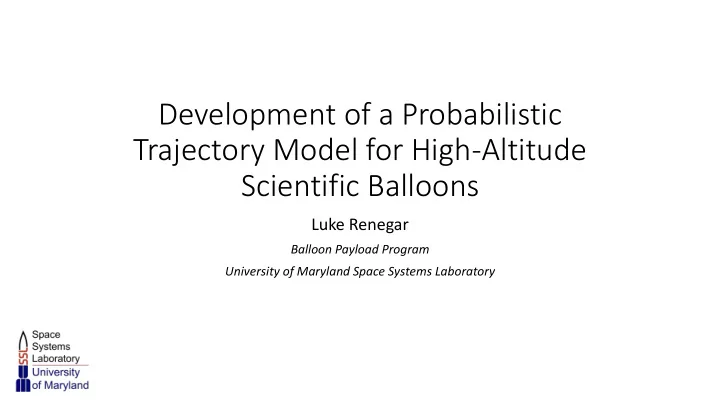

Development of a Probabilistic Trajectory Model for High-Altitude Scientific Balloons Luke Renegar Balloon Payload Program University of Maryland Space Systems Laboratory
Background on Scientific Ballooning • Provides inexpensive, long-duration access to upper atmosphere • 80-120 kft (25-36 km) • Payloads range from <1 kg to 3500 kg • Typically made out of latex/substitute or polyethylene • Latex balloons burst; polyethylene balloons float and must be terminated
Phases of a Latex Balloon Flight
Importance of Trajectory • FAA requires that balloons not “create […] a hazard to persons or property not associated with the operation”, nor penetrate restricted airspace (14 C.F.R. 101) • Can’t land in urban areas, near airports or national security sites • Want to recover equipment • No water landings • Need to know where to send recovery team
How to predict trajectory? • Initial value problem • Find forces on balloon • Integrate kinematic equations
Forces on a balloon 𝐺 𝐶 = 𝜍 𝐼𝑓 𝑊 Ƹ 𝑨 𝐸 = − 1 𝐺 2 𝜍 𝑏𝑗𝑠 𝐷 𝐸 𝐵 𝑞𝑠𝑝𝑘 𝑊 𝑠𝑓𝑚 𝑊 𝑠𝑓𝑚 𝐺 𝑋 = −𝑛 𝑡𝑧𝑡 Ƹ 𝑨 𝑛 𝑡𝑧𝑡 = 𝑛 𝐼𝑓 + 𝑛 𝑑𝑏𝑜𝑝𝑞𝑧 + 𝑛 𝑞𝑏𝑧𝑚𝑝𝑏𝑒
Internal Temperature and Pressure Data credit: UMDBPP/J. Breeden and C. Bernard
ሶ ሶ Thermal Loads on the Balloon 𝑅 𝑡𝑣𝑜 + ሶ 𝑅 𝑏𝑚𝑐 + ሶ 𝑅 𝑠𝑝𝑣𝑜𝑒 + ሶ 𝑅 𝑏𝑢𝑛 − ሶ 𝑅 𝐼𝑓 − ሶ 𝑒𝑈 𝑅 𝐽𝑆 𝑑 dt = c c m c 𝑒𝑈 𝐼𝑓 𝑅 𝐼𝑓 + 𝛿 − 1 𝑈 He 𝑒𝜍 He = dt 𝑑 𝑤 m He 𝜍 He 𝑒𝑢
Effect of Reynolds Number on C D Models: Conner, Morrison
Obtaining Atmospheric Data • Atmospheric state, especially wind, critically influences trajectory • Obtained from NOAA’s Global Forecast System (GFS) model • 0.5° x 0.5° x 2.5 kPa spatial resolution • 3-hour temporal resolution • Run every 6 hours • Parameters obtained: • Wind (u and v) • Temperature • Pressure • Albedo • Ground temperature
First-Order Simplifications • Wind will rapidly drive horizontal velocity to wind velocity • Balloon ascends at a “terminal velocity” determined by drag • Altitude-dependent, but changes slowly • Compute velocity directly, rather than integrating acceleration • Reduces number of states from 8 to 5
Model steps Start End Initialize Y Get N Reached atmospheric ground? data N Compute Diameter Get Y Integrate one Integrate one canopy > burst atmospheric step ascent step descent diameter diameter? data
Estimating Uncertainty • The prediction process is deterministic • Trajectory predictions are necessarily uncertain • Environmental parameters are only predictions • Burst diameter varies between balloons • Process is stochastic • Randomly vary inputs to estimate most probable landing site
Ascent Rate and Burst Uncertainty • Dominant factors in ascent rate are helium mass, C D • Normally distribute helium mass about nominal value • Helium mass is measured at launch • Multiply C D by a unity-mean normal deviate • Burst diameter affects overall length of track • Treat burst diameter as a Weibull variable • Burst diameter is a measure of lifetime
Wind Uncertainty • Wind exhibits strong correlation across altitudes • Vary wind as a function of latitude, longitude only • Wind is a vector quantity • Can’t treat components independently • Vary direction normally • Multiply magnitude by unity-mean normal deviate
Model Output
Future work • Model validation with flight data • Development of a payload drag coefficient model • Current model underestimates vehicle drag coefficient
Citations • “14 C.F.R. 101,” Code of Federal Regulations, n.d. • Breeden, J., “High Altitude Weather Balloon Venting and Balloon Dynamics,” Region I Student Conference, AIAA, 2017. • Conner , J. P., and Arena, A. S., “"Near Space Balloon Performance Predictions",” AIAA Aerospace Sciences Meeting, Vol. 48, AIAA, 2010. doi:10.2514/6.2010-37. • Morrison , F. A., “"Data Correlation for Drag Coefficient for Sphere",” Tech. rep., 2016. URL www.chem.mtu.edu/~fmorriso/DataCorrelationForSphereDrag2016.pdf.
Questions?
Recommend
More recommend